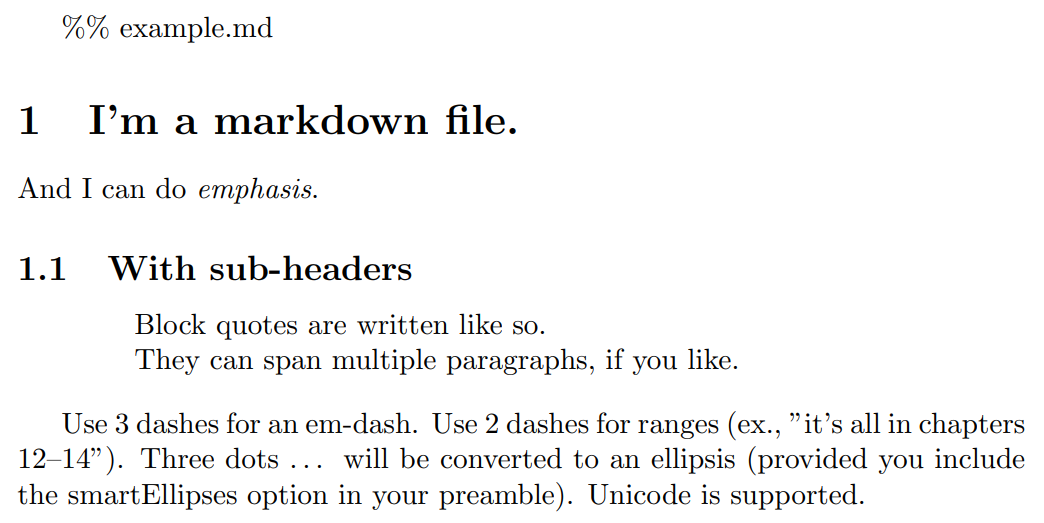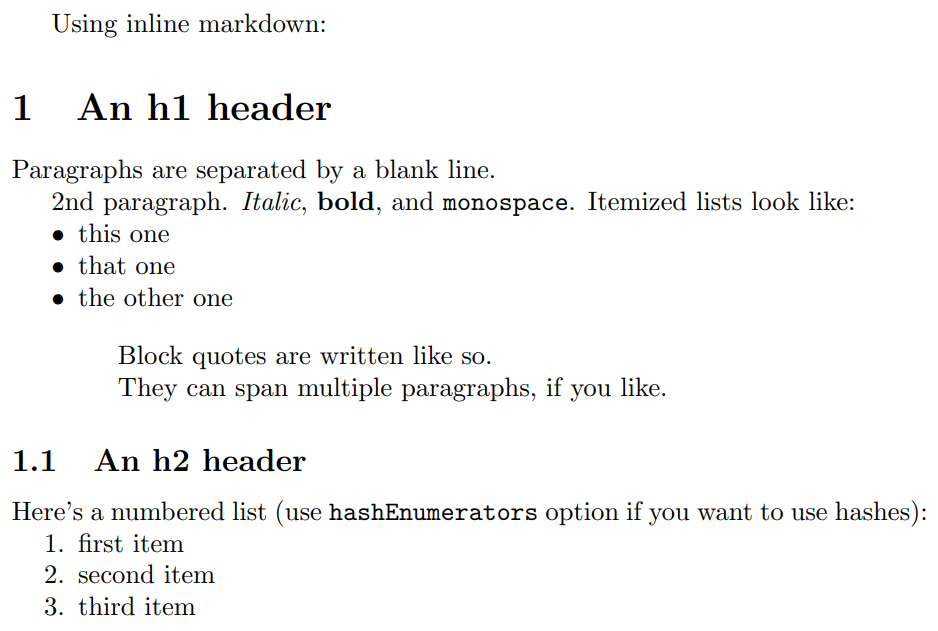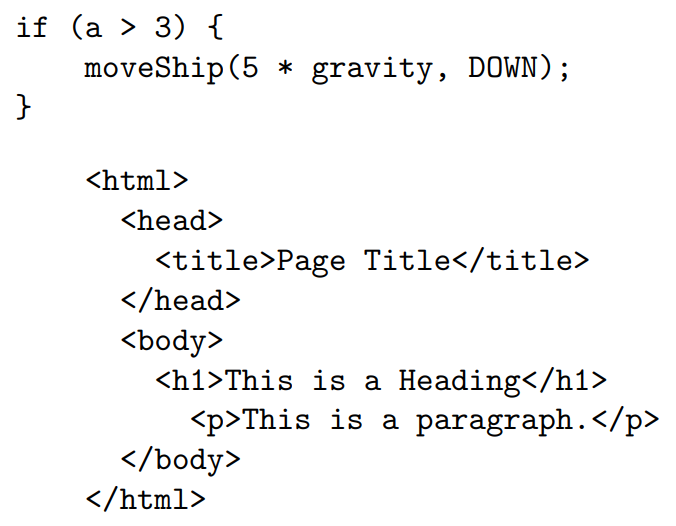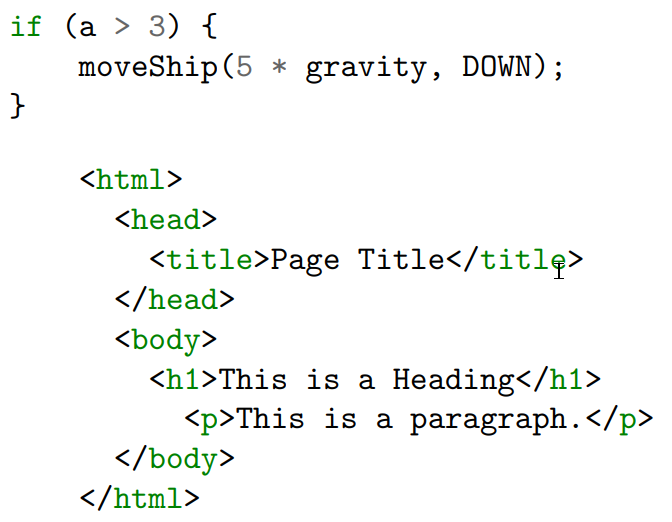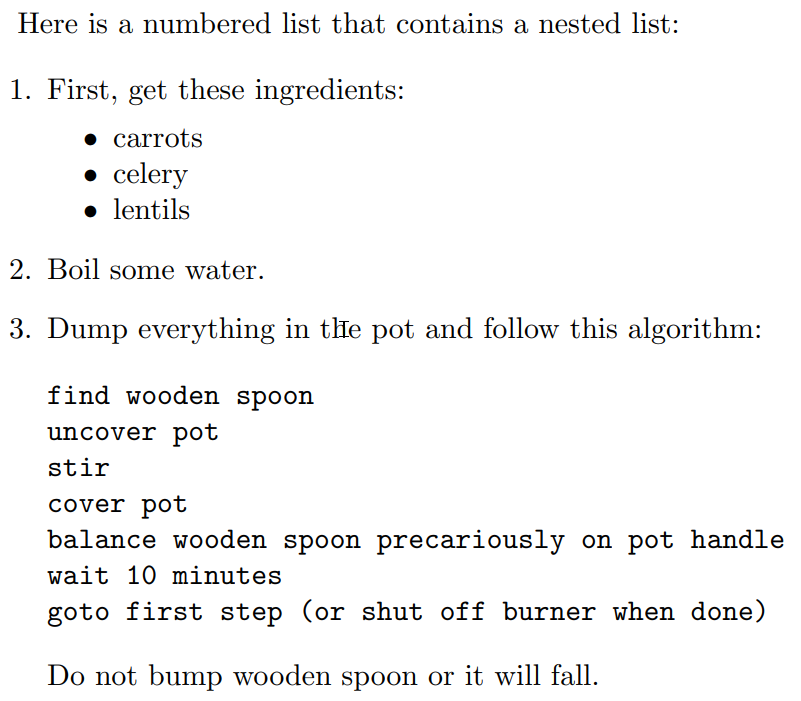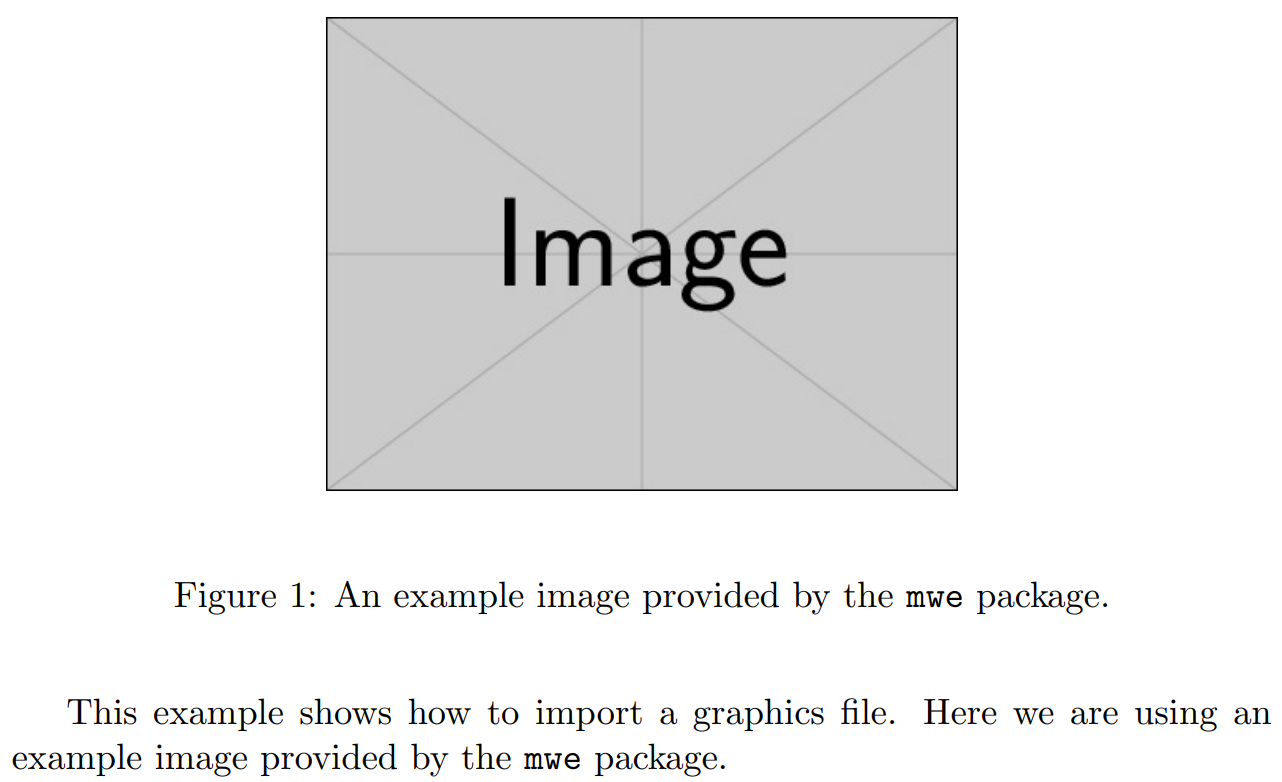| Writing Markdown in LaTeX Documents | 您所在的位置:网站首页 › overleaf导出LaTeX代码 › Writing Markdown in LaTeX Documents |
Writing Markdown in LaTeX Documents
|
Contents
1 Introduction
2 Using external markdown files
3 Using inline markdown
4 Markdown package features and options
4.1 Including code in markdown
4.1.1 Using indentation to display code blocks
4.1.2 Using fenced code blocks
4.1.3 Syntax highlighting
4.2 Lists
4.3 Including LaTeX inside markdown
4.4 Including images
4.4.1 Note on the image width
5 Further reading
Introduction
To use markdown in a LaTeX document you need to load the markdown package in your document preamble: \usepackage[settings]{markdown} where [settings] is an optional set of parameters used to configure or enable specific package features. Refer to the markdown package documentation for a description of the package parameters (options). This article will briefly review both inline markdown—written within your document—and importing external markdown contained in a text file. Advisory note: Generally, use of markdown within a LaTeX document should be treated as a complementary and convenient option for authoring some elements of your document's content, not as an alternative syntax to fully replace LaTeX itself. Using external markdown filesUse the command \markdownInput{filename} to include the markdown file filename. The following example inserts a file called example.md. Use the link below the code listings to open them as an Overleaf project: main.tex \documentclass{article} \title{Using the markdown package} \usepackage[smartEllipses]{markdown} \begin{document} \markdownInput{example.md} \end{document}example.md %% example.md # I'm a markdown file. And I can do *emphasis*. ## With sub-headers > Block quotes are > written like so. > > They can span multiple paragraphs, > if you like. Use 3 dashes for an em-dash. Use 2 dashes for ranges (ex., "it's all in chapters 12--14"). Three dots ... will be converted to an ellipsis (provided you include the smartEllipses option in your preamble). Unicode is supported.Open these files as an Overleaf project. This example produces the following output:
Use the markdown environment: \begin{markdown} ...your markdown goes here... \end{markdown} to write inline markdown, as demonstrated by the next example: \documentclass{article} \usepackage[hashEnumerators,smartEllipses]{markdown} \begin{document} Using inline markdown: \begin{markdown} An h1 header ============ Paragraphs are separated by a blank line. 2nd paragraph. *Italic*, **bold**, and `monospace`. Itemized lists look like: * this one * that one * the other one > Block quotes are > written like so. > > They can span multiple paragraphs, > if you like. An h2 header ------------ Here's a numbered list (use `hashEnumerators` option if you want to use hashes): #. first item #. second item #. third item \end{markdown} \end{document}Open this example in Overleaf. This example produces the following output:
Here will we explore a few of the features and options provided by the markdown package. Including code in markdownThere are two mechanisms for displaying snippets of code (code blocks) within markdown: indenting every line of the block by at least four spaces or one tab, or using so-called fenced code blocks Using indentation to display code blocksThe following example uses 4, or more, space characters at the start of each line of code—some lines use 6, 8 or 10 space characters depending on the size of indent required: \documentclass{article} \usepackage{markdown} \begin{document} Here are some code fragments indented by at least 4 space characters. \vspace{6mm} \begin{markdown} Here is a fragment of C: /* Let me iterate ... */ int i; for(i=0; i 3) { moveShip(5 * gravity, DOWN); } ``` ``` Page Title This is a HeadingThis is a paragraph. ``` \end{markdown} \end{document}Open this example in Overleaf. This example produces the following output:
Fenced code blocks support syntax highlighting by having the name of the language written after the first set of backticks (`). As an example, the following block is identified as Javascript by writing the first set of backticks as ``` js: ``` js if (a > 3) { moveShip(5 * gravity, DOWN); } ``` For LaTeX, the minted package can be used for syntax highlighting, as shown in the next example which contains some Javascript (``` js) and HTML (``` html): \documentclass{article} \usepackage{minted} \usepackage[fencedCode]{markdown} \begin{document} \begin{markdown} ``` js if (a > 3) { moveShip(5 * gravity, DOWN); } ``` ``` html Page Title This is a HeadingThis is a paragraph. ``` \end{markdown} \end{document}Open this example in Overleaf. This example produces the following output:
Previous examples demonstrate creating unordered lists in markdown using the * character. Ordered lists can be created using the # character if the hashEnumerators option has been specified: \usepackage[hashEnumerators]{markdown} It is also possible to create nested lists, as demonstrated in the next example: \documentclass{article} \usepackage[hashEnumerators]{markdown} \begin{document} \begin{markdown} Here is a numbered list that contains a nested list: #. First, get these ingredients: * carrots * celery * lentils #. Boil some water. #. Dump everything in the pot and follow this algorithm: find wooden spoon uncover pot stir cover pot balance wooden spoon precariously on pot handle wait 10 minutes goto first step (or shut off burner when done) Do not bump wooden spoon or it will fall. \end{markdown} \end{document}Open this example in Overleaf. This example produces the following output:
If you enable the hybrid option you can mix LaTeX code in Markdown! \documentclass{article} \usepackage[hybrid]{markdown} \begin{document} \begin{markdown} Inline math equations can be created like this: $\omega = d\phi / dt$. Display math can be written as: \begin{equation} I = \int \rho R^{2} dV \end{equation} \end{markdown} \end{document}Open this example in Overleaf. This example produces the following output:
Images can be included in markdown by writing markup of the following format:  Hopefully, the parameter names alt-text, file-name and "image caption" describe what they do. Here is an example to demonstrate them: \documentclass{article} \usepackage[hybrid]{markdown} % The mwe package provides example images. Loading it is % not essential because those images are in LaTeX's search path. % Here, we load it for clarity in this example. \usepackage{mwe} \begin{document} \begin{markdown} This example shows how to import a graphics file. Here we are using an example image provided by the `mwe` package. % Use \setkeys{Gin} if you need to change an image's display size \setkeys{Gin}{width=.5\linewidth}  \end{markdown} \end{document}Open this example on Overleaf. This example produces the following output:
Like most packages, markdown loads other packages, including keyval and graphicx, to make use of the commands and features they provide. Here, the image width is set using the \setkeys command, which is provided by keyvals. Gin is a "family" of keys defined by the graphicx package. Note: Because a LaTeX command, here \setkeys, is used within the markdown environment, the hybrid option of the markdown package is required. Further readingOverleaf has published other articles on using markdown: How to write in Markdown on Overleaf Markdown into LaTeX with Style |
【本文地址】
